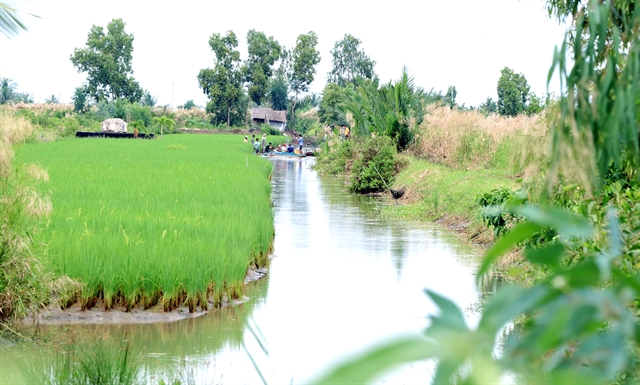 Society
Society

 |
| Shrimp-rice farming fields in Cà Mau Province. — VNA/VNS Photo Huỳnh Anh |
CÀ MAU — The Cửu Long (Mekong) Delta province of Cà Mau plans to diversify its aquaculture and farming models to develop them effectively and sustainably.
The country’s southernmost province and largest shrimp producer has more than 300,000ha of aquaculture ponds, including 280,000ha to raise shrimp.
It plans to expand efficient shrimp farming models such as shrimp-rice, shrimp-forest and super-intensive shrimp farming this year, according to its Department of Agriculture and Rural Development.
The super-intensive farming area has increased from 175ha in 2016 to 4,322ha now.
Đặng Văn Hải, a member of the Hòa Thành Commune high productivity shrimp breeding farmers’ club in Cà Mau City, said the model helps manage the quality of breeding water well and prevent diseases and is suitable for small scale farming.
The province has 80,000ha under the shrimp-forest model, with more than 19,000ha obtaining international quality certification such as GlobalGAP, Global Aquaculture Stewardship Council and Best Aquaculture Practices, according to the department.
In Ngọc Hiển District, 9,300ha of shrimp-forest farming areas have international quality certification and an average yield of 200-240 kilogrammes a year, according to the local Bureau of Agriculture and Rural Development.
The model is applied widely in areas in Ngọc Hiển, Năm Căn and Đầm Dơi districts with farmers breeding organic shrimp for both domestic distribution and exports.
Trương Việt Bắc, deputy head of the Đầm Dơi District Protective Forest Management Board, said the shrimp-forest model in the district has been efficient and helped improve local people’s lives.
The board has allocated more than 8,200ha of mangrove forests to local households to protect and exploit, he said.
It is collaborating with seafood processing companies to breed organic shrimp and develop an origin tracing system that would help increase value, he said.
The project aims to have 1,200ha and the participation of 500 households, he added.
Trương Tấn Sĩ, a farmer in Đầm Dơi’s Nguyễn Huân Commune, said: “More farmers are switching to this model.”
His family has 6.4ha and earns an average of VNĐ60 million (US$2,600) a year and plans to switch to organic farming, he said.
“The income is expected to increase.”
Farmers undertaking shrimp-rice farming in Năm Căn, Đầm Dơi and Ngọc Hiển districts earn an average of VNĐ80 million ($3,400) per hectare per year, according to the department.
The province also aims to expand the breeding of other aquatic species such as oysters, blood cockles, mud crabs, and marine fish this year.
On 250,000ha farmers raise mud crabs in fields and get a yield of 100 kilogrammes per hectare per year.
Mud crabs are a key fisheries item for the province, ranking after only shrimp, and are mostly raised in shrimp ponds.
The province, the country’s largest producer of the crabs and having geographical indication awarded by the National Office of Intellectual Property, earns more than VNĐ10 trillion ($420 million) from them annually, according to the department.
It has a coastline of more than 254 kilometres, many estuaries, mud flats and islands, and encourages farmers and companies to raise marine aquatic species.
In Chuối and Đá Bạc islands in Trần Văn Thời District, for instance, farmers breed marine fish, mostly cobia and groupers, in nearly 200 floating cages measuring a total of 10,000sq.m.
This is a highly efficient model, according to local farmers.
Cà Mau targets seafood and aquaculture output of 640,000 tonnes this year, including 243,000 tonnes of shrimp, according to the department.
For this, it will zone shrimp farming areas and develop linkages among stakeholders to increase the farming area, efficiency and output, it said.
The output last year was 622,000 tonnes after increasing by 2.2 per cent. Of this, 386,000 tonnes were from aquaculture, 5.3 per cent up from 2021.
It exported more than $1.3 billion worth of shrimp last year, an increase of 16.5 per cent.
The province has around 32 shrimp processing plants, which are equipped with advanced facilities and have an annual capacity of 250,000 tonnes.
The shrimp industry provides livelihoods to more than 600,000 people, or half the province’s population. — VNS




